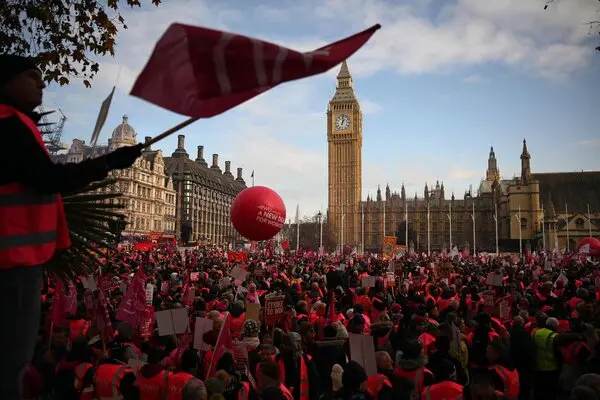In the last two months alone, a dozen days of strikes and mass mobilizations have taken place in France against the pension reform. French president Emmanuel Macron used the antidemocratic Article 49.3 of the French constitution to push through his pension reform, signifying a new level of his Bonapartist attempts to advance this agenda, one that is being denounced in the streets and rejected by the majority of the French population. This opened an inflection point and a new stage of radicalization in the struggle, which saw the multiplication of spontaneous mobilizations, strikes in strategic sectors, blockades of major roadways, occupations of high schools and universities, and intense confrontations with the police. This process of class struggle in France is the most advanced on the Continent, and we have followed it closely in many articles. Here, I will focus on what is happening in other strike waves across Europe, to get a panoramic view of the situation and address some of the strategic debates they have opened.
On the other side of the English Channel, the United Kingdom is experiencing the biggest strike wave in half a century; in Greece, there have already been three general strikes since the fateful train disaster on February 28. In Germany, the largest strike of transport and public services workers in 30 years paralyzed the country on March 27. In Portugal, the press described a “winter of discontent” as the country saw a wave of national strikes of teachers, sanitation workers, and railway workers. Europe has not seen this level of labor militancy since the capitalist crisis of 2008.
The Strikes as a Catalyst for Profound Discontent
On February 11, 140,000 teachers took to the streets in Lisbon, marking this sector’s largest demonstration in the last decade. “I am here for my students, for my precarious colleagues, for issues that involve older workers, for the stagnation [of wages],” explained María Guerra, a professor in Leiria (a town located 150 kilometers north of the Portuguese capital). Teachers were left “exhausted” after the pandemic, and now they are being hit by inflation. And although these teachers were protesting for better salaries and working conditions, their strike channeled a much broader and accumulated malaise.
In Greece, strikes and protests erupted after the train disaster that killed 57 people on February 28. Many of those who died were workers and university students. But the mobilizations in the country also express an accumulated anger along multiple axes. “Pain has turned into rage for the dozens of comrades and citizens killed and injured,” said Greece’s main railway union in a press release. Since then, three strikes were called on March 8, March 13, and March 16; added to this were strikes by metro workers and two weeks of strikes by railway workers in the rest of the country. The strike on March 8, called by workers in the public sector, was highlighted in the press for numbers of people taking part in the demonstrations and the participation of young people. Some towns, such as Patras, Volos, Heraklion, or Mytilene, “had not seen such large protests since the end of the dictatorship in 1974.”
During the general strike on March 16, called by unions in both the public and private sectors — namely the Confederation of Greek Civil Servants’ Trade Unions (ADEDY) and General Confederation of Greek Workers (GSEE) — airports were emptied, boats could not leave the ports that connect Greece’s many islands, and trains, metros, buses, and taxis were stopped across the country. The public sector turned out in force for the strike, with healthcare and education workers taking part in large demonstrations in all the major cities. These resulted in clashes with the police and forceful repression. Images not seen since before Syriza took power in 2015 were plastered across the news and social media. The deterioration of public services is a direct consequence of privatization and austerity imposed by the Troika 12 years ago and carried out by both conservatives and neoreformists, such as those in Syriza. In the present moment, this has combined explosively with an inflation crisis accelerated by the war in Ukraine.
Rising inflation has also triggered large strikes in Germany, which for months now have been organized in hospitals, schools, post offices, and ports. The “mega-strike” by transport workers on March 27 paralyzed most of the country. Inflation in Germany rose to 8.7 percent in February. Workers organized in the Railway and Transport Union (EVG) and the United Services Trade Union (Ver.di) are demanding a salary increase of 10.5 percent, while the bosses have offered them a measly 5 percent, plus an additional bonus. The coordination of both these unions is something unprecedented in recent years. The strike was accompanied by mobilizations in dozens of cities and raised significant debate in the press. Despite the bosses’ best efforts to agitate against the strike, the day passed calmly. The unions have so far not called for additional actions, instead announcing that they will return to the negotiating table.
Healthcare Workers Say, “No!”
In the United Kingdom, the height of the mobilizations came with the mega-strike on February 1. Many journalists described it as a de facto general strike, because workers across sectors staged the strike together — railway workers, public sector workers, nurses, firefighters, teachers, university professors, and others. That day, over 500,000 workers took to the streets to protest the rising costs of living.
In the private sector, the strikes have achieved some important victories. For example, in mid-February, bus drivers in London lifted their strike after winning a record-breaking 18 percent salary increase. In the public sector, Prime Minister Rishi Sunak’s government has maintained a hardline stance and used quasi-Thatcherite rhetoric against the striking workers to promote his anti-union legislation. As a result, the string of strikes in the public sector has acquired a more political tinge, in open confrontation with the government. More recently, Sunak has tried to reach separate agreements with different unions. On March 16, he reached an agreement with the unions of the NHS to temporarily halt the strikes and to offer a 5 percent salary increase, plus bonuses for work performed during the pandemic. According to British law, proposed agreements open a consultation period among members to discuss whether to ratify the deal. All the unions, with the exception of UNITE, are hailing the agreement as a triumph and have called to ratify it when the consultation period ends in mid to late April.
What is most interesting is that in recent weeks a cross-union campaign has emerged calling for the rejection of the government’s offer, both among NHS workers and in education unions. Using the slogan “NHS Workers Say NO!,” campaigns have been opened with arguments about why to reject these recent offers and to instead continue the strikes (though there are no concrete proposals for this). As one union declaration said, “We were heroes during the pandemic, but as soon as we tried to improve our pay, we became the enemy. We know that there are people all over the country who support us and we must not give in to attempts to divide us. Let’s stay strong, let’s stay angry, let’s stay together, all categories, all disciplines, all unions.” The result of the consultation period will define the outlook for the coming months, though the strategy of the majority of the unions is to bet on a change in government in 2024 that would put the Labour Party in power, after more than a decade of Conservative Party governments.
The strikes in the healthcare sector have been a common element in many countries after the pandemic. In the Spanish State, massive demonstrations for public health have developed in cities across the countries. In Madrid, a “white wave” filled the streets on February 12; hundreds of thousands of people came out to support striking primary care doctors and to denounce the deterioration of public health services. There have also been labor struggles in other sectors and even some that have won victories, such Inditex-Zara workers, who won wage increases of over 15 percent.
The union leaderships try to separate the strikes by sector, without calling to leave them open-ended and without a program to unite permanent and outsourced workers or workers inside and outside the hospitals. The bureaucracies have not called a general strike in the Spanish State for a decade (the last one was on November 14, 2012). With a relatively controlled inflation rate of 3.3 percent in March (although it has risen to 7.6 percent on food items), the Spanish State’s largest union, the Workers’ Commission (CCOO), and the General Union of Workers (UGT) have imposed a “social peace” together with the Communist Party Minister of Labor, Yolanda Díaz, and the “progressive” government of PSOE-Podemos. In an election year, with local elections in May and general elections at the end of the year, the bureaucracies and the reformist Left are gambling on a “lesser evil” campaign against the right wing in order to maintain a coalition government with the social-liberal PSOE.
An Uneven Return of Class Struggle
These strike processes have been marked by the new economic and political conditions opened on the Continent after the pandemic, rising inflation, and the war in Ukraine. While the governments of the main European powers have increased military spending and the war offensive through NATO, the “internal front” has begun to crack and show important contradictions. This is indicated by the return — albeit uneven — of class struggle in Europe. And as the governments respond to the protests with increasingly Bonapartist measures and harsh repression (as in the case of Macron), the rage is spreading.
At the moment, the most advanced place is France. What happens there will have an impact beyond its borders. There, tendencies toward self-activity on the part of the most combative sectors of workers have begun to emerge, whether by means of militant strikes, seeking coordination or rejecting the betrayals of the bureaucracies.
What is true more broadly, however, is that in several countries in the region there is a trend toward greater intervention by the working class to fight for wage recovery or better working conditions. In most cases, the union bureaucracies have so far been able to divide and pacify the strikes from within. At the same time, as Santiago Lupe has written, “the other great point in common between the different national bureaucracies is how they are acting as a real arm of the state to zealously preside over strikes and workers’ unrest and prevent any challenge to the imperialist policies of their respective governments.” That is to say, the bureaucracies aim to avoid linking the struggles of the “internal front” to any challenge to the imperialist foreign policy of their governments.
Another important element is the participation and solidarity of youth sectors in the mobilizations and strikes, as is certainly the case in France, but also in Greece and the United Kingdom. Young people have been hit by precariousness and have been politicized by movements against the climate crisis, sexism, and racism. They feel that they owe nothing to capitalism, and many are radicalizing in the heat of the new experiences of struggle. This is an important countertrend to dystopian ideas of “no future” and the individualism among other sectors of young people, as well as to the influence of the extreme Right, which seeks to take advantage of this malaise.
The strike wave is not yet comparable with the profound workers’ and popular upsurge of the French May, the Italian Hot Autumn, or the Prague Spring, the last great revolutionary upsurges of the working class on the European continent, which were marked by workers’ and youth radicalization. Their image emerges, however, as a flash, when we see sectors of the French youth mobilizing in the early hours of the morning to support a workers’ picket line and confront police repression, or when workers of the most important refinery in France call for an open-ended general strike. In these examples we can glimpse the potential of a working class that, when it is predisposed to fight, can rally sectors of the youth, the anti-racist movement, and the feminist movement behind class struggle and against imperialist governments and capitalism.
From the eruption of the great capitalist crisis of 2008 to today, we have seen a return of the class struggle that has unfolded in various cycles, without surpassing the initial moment of revolt; they have often taken the form of a combination of partial strikes, controlled by the union bureaucracies, and more massive “revolt-like” phenomena, such as the Yellow Vests movement or youth protests. In this framework, various mechanisms have repeatedly operated to divert the mobilization toward different forms of institutionalization, with the aim of achieving the recomposition of the political regimes in crisis.1To go deeper into this topic, we recommend Matías Maiello’s De la movilización a la revolución (Buenos Aires: Ediciones IPS, 2022).
The reformist Left that is grouped around the figure of Mélenchon in France — who is supported even by sectors of the Left like the NPA — pretend to funnel all the discontent, the mobilizations, and the strikes toward a hypothetical electoral alternative and a “left government” that operates within the bourgeois regime. The trade union leaderships in the United Kingdom are acting in the same way, trying to strengthen the electoral base of Labour; the same is true of the neoreformist Left in the Spanish State, which bets on “lesser-evilism” to make electoral gains.
The current processes, like the one developing in France, and more incipiently in other countries, raise some new elements. Faced with the rapid deterioration of living conditions and the Bonapartist hardening of their governments — which accompanies the policy of imperialist rearmament — workers and youth sectors are beginning to radicalize, while broad sectors of the working class are beginning to awaken. This raises the possibility of advancing toward a new moment in the class struggle, but only if the politics of the trade union bureaucracies and the reformists can be overcome.
The comrades of Révolution Permanente in France have been putting this perspective forward, promoting the Network for the General Strike as a pole that groups together sectors that want to continue and unify the fight. They are calling for the formation of action committees for the general strike; a list of demands to unite the whole working class; and a policy of class independence, with the goal of defeating the Macron government using the methods of class struggle. The political and programmatic struggle against the bureaucracies and the reformist currents is key for advanced sectors of the working class and the youth to go through the experience with their traditional treacherous leaderships and draw conclusions about the need for an independent, anti-capitalist, socialist, and revolutionary perspective
Originally published in Spanish on April 2, 2023 in Ideas de Izquierda.
Translated by Madeleine Freeman
Notes
| ↑1 | To go deeper into this topic, we recommend Matías Maiello’s De la movilización a la revolución (Buenos Aires: Ediciones IPS, 2022). |
|---|











